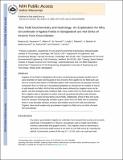| dc.contributor.author | Neumann, Rebecca B. | |
| dc.contributor.author | St. Vincent, Allison P. | |
| dc.contributor.author | Roberts, Linda C. | |
| dc.contributor.author | Badruzzaman, A. Borhan M. | |
| dc.contributor.author | Ali, M. Ashraf | |
| dc.contributor.author | Harvey, Charles F | |
| dc.date.accessioned | 2014-09-12T18:16:15Z | |
| dc.date.available | 2014-09-12T18:16:15Z | |
| dc.date.issued | 2011-02 | |
| dc.date.submitted | 2010-12 | |
| dc.identifier.issn | 0013-936X | |
| dc.identifier.issn | 1520-5851 | |
| dc.identifier.uri | http://hdl.handle.net/1721.1/89475 | |
| dc.description.abstract | Irrigation of rice fields in Bangladesh with arsenic-contaminated groundwater transfers tens of cubic kilometers of water and thousands of tons of arsenic from aquifers to rice fields each year. Here we combine observations of infiltration patterns with measurements of porewater chemical composition from our field site in Munshiganj Bangladesh to characterize the mobility of arsenic in soils beneath rice fields. We find that very little arsenic delivered by irrigation returns to the aquifer, and that recharging water mobilizes little, if any, arsenic from rice field subsoils. Arsenic from irrigation water is deposited on surface soils and sequestered along flow paths that pass through bunds, the raised soil boundaries around fields. Additionally, timing of flow into bunds limits the transport of biologically available organic carbon from rice fields into the subsurface where it could stimulate reduction processes that mobilize arsenic from soils and sediments. Together, these results explain why groundwater irrigated rice fields act as net sinks of arsenic from groundwater. | en_US |
| dc.description.sponsorship | Singapore-MIT Alliance for Research and Technology. Center for Environmental Sensing and Monitoring | en_US |
| dc.description.sponsorship | National Institutes of Health (U.S.) (Award P42 ES01645) | en_US |
| dc.language.iso | en_US | |
| dc.publisher | American Chemical Society (ACS) | en_US |
| dc.relation.isversionof | http://dx.doi.org/10.1021/es102635d | en_US |
| dc.rights | Article is made available in accordance with the publisher's policy and may be subject to US copyright law. Please refer to the publisher's site for terms of use. | en_US |
| dc.source | PMC | en_US |
| dc.title | Rice Field Geochemistry and Hydrology: An Explanation for Why Groundwater Irrigated Fields in Bangladesh are Net Sinks of Arsenic from Groundwater | en_US |
| dc.type | Article | en_US |
| dc.identifier.citation | Neumann, Rebecca B., Allison P. St. Vincent, Linda C. Roberts, A. Borhan M. Badruzzaman, M. Ashraf Ali, and Charles F. Harvey. “Rice Field Geochemistry and Hydrology: An Explanation for Why Groundwater Irrigated Fields in Bangladesh Are Net Sinks of Arsenic from Groundwater.” Environ. Sci. Technol. 45, no. 6 (March 15, 2011): 2072–2078. | en_US |
| dc.contributor.department | Massachusetts Institute of Technology. Department of Civil and Environmental Engineering | en_US |
| dc.contributor.department | Parsons Laboratory for Environmental Science and Engineering (Massachusetts Institute of Technology) | en_US |
| dc.contributor.mitauthor | Neumann, Rebecca B. | en_US |
| dc.contributor.mitauthor | St. Vincent, Allison P. | en_US |
| dc.contributor.mitauthor | Harvey, Charles F. | en_US |
| dc.relation.journal | Environmental Science & Technology | en_US |
| dc.eprint.version | Author's final manuscript | en_US |
| dc.type.uri | http://purl.org/eprint/type/JournalArticle | en_US |
| eprint.status | http://purl.org/eprint/status/PeerReviewed | en_US |
| dspace.orderedauthors | Neumann, Rebecca B.; St. Vincent, Allison P.; Roberts, Linda C.; Badruzzaman, A. Borhan M.; Ali, M. Ashraf; Harvey, Charles F. | en_US |
| dc.identifier.orcid | https://orcid.org/0000-0002-7759-4447 | |
| mit.license | PUBLISHER_POLICY | en_US |
| mit.metadata.status | Complete | |
